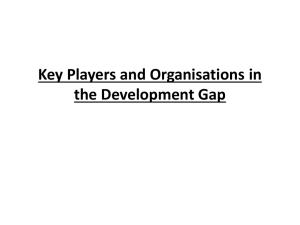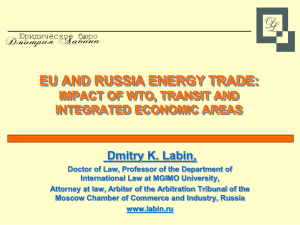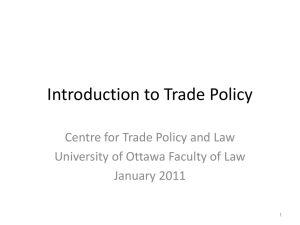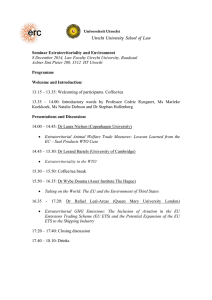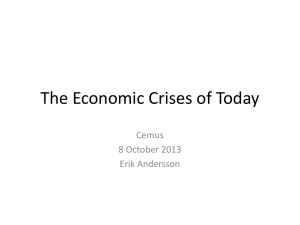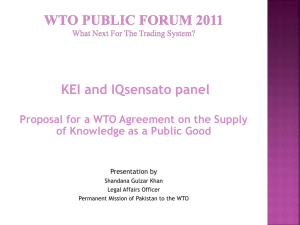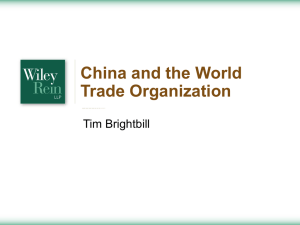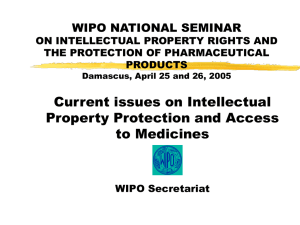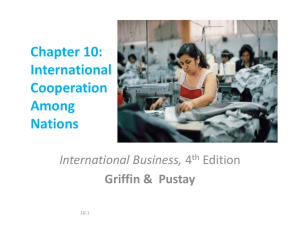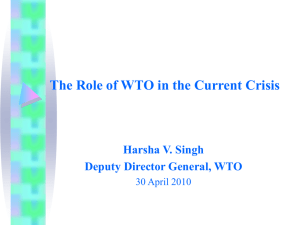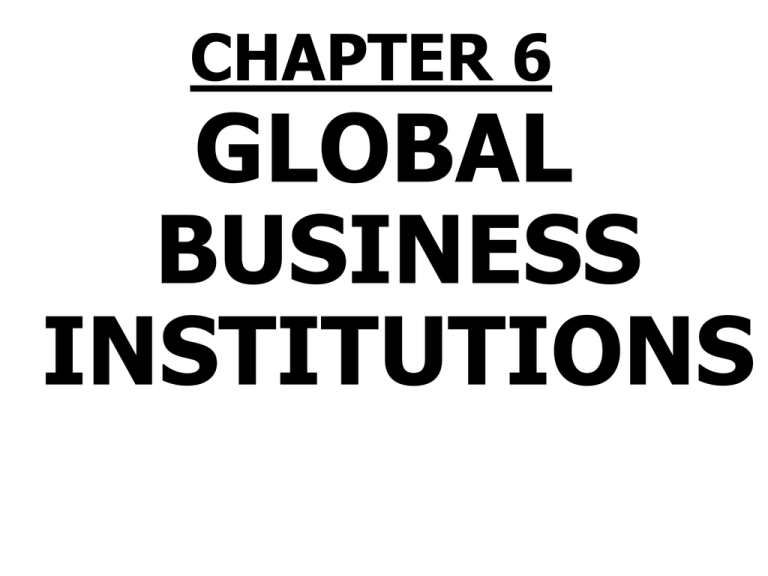
CHAPTER 6
GLOBAL
BUSINESS
INSTITUTIONS
Global Business Institutions PRISMS
1. Private vs. community
capitalism
2. GGOs vs. NGOs
3. Godzillas vs. Tigers
4. The benefits vs. costs of free
trade
5. Should GGOs support both
cultural forms of capitalism?
6. Should human rights replace
national sovereignty as the key
goal of nations?
7. Is defensive protectionism
justifiable when
underdeveloped nations are
threatened by Global 500
corporations?
8. Should rich nations be required
to engage in import
substitution?
9. Does the IMF have an agenda to
convert Tiger nations to private
capitalism?
10. Should the international debt of
struggling Tiger nations be
cancelled?
11. Should the IMF be reformed or even
dissolved?
12. Should governments use their
corporations as a foreign policy tool?
13. Is private capitalism a form of
nationalism?
ENTERING THE LAST ERA OF HUMAN HISTORY?
Families
Clans
Villages
Cities
Nations
Regions
Tribes
Era of internationalism
(multilateralism) over nationalism
There’s no bigger
dimension for the
world to grow
into unless it’s
interplanetary
trade!
“A new global civilization has emerged
whose identity lies not just in the norms
of dress, advertising, multinational
brands, or the constant buzz of world
music. Technology has enabled our planet
to be covered by a single civilization for
the first time in human history. It is now
enmeshed in tiny capillaries that not only
transmit information at lightning speed but
also convey integrated norms of social,
political, & economic behavior.”
WHY NATION STATES ARE DECLINING
1. Nations are becoming so economically
interdependent that regionalization is
becoming a new force.
2. People are more mobile than ever before.
3. Minority populations in a growing number of
nations are assertively demanding greater
self-determination.
4. Global corporations can meet the consumer
needs of the world’s population better than
most national governments.
5. New global problems have emerged that
require the cooperation of nations: terrorism,
global warming, illegal immigration, disease
pandemics.
ST
21
A NEW
CENTURY
GLOBAL
ORDER
The 21st century political & economic order
is no longer based on second-half 20th
century Cold War American capitalism
vs. Soviet Communism. According to
new global thinker George Friedman,
the 21st century global structure is
overbalanced in favor of U.S. hegemony,
because America is for the time being
the only truly global power. But another
21st thinker, Fareed Zakaria, asserts that
we are living in a “Post-American” world
where the U.S. is not declining as much
as other developing nations (led by
China, India, & several South American
nations) are rising.
These rising 21st century powers will
eventually move to form (primarily
economic) coalitions as a counterbalance
to U.S. dominance. New variants of
capitalism are emerging better suited to
the cultures of developing nations, posing
a long-term challenge to the Western “neoliberal” Adam Smith ideology (profit
maximization, single-stakeholder
nationalist) capitalism. In this “postAmerican” emerging world structure, the
U.S. will have to decide if it wants to
participate in shaping the new order via
multilateral policy consultation, or settle
for a less dominant global role as the
British acquiesced to in the 20th century.
NEW EMERGING GLOBAL
INFRASTRUCTURE FOR THE 21 CENTURY
1. Global Government
Organizations (GGOs)
2. Non-Government
Organizations (NGOs)
3. Global Public Policy
Networks (GPPNs)
GGOs TODAY
1. International Monetary Fund
(Authority over nations that
borrow money)
2. International Labor Organization
(U.N.) (Authority over human
rights violations in the global
workplace)
3. World Trade Organization
(Authority over nations in trading
practices)
4. International Standards
Organization (Mandates standards
for all phases of global business
operations)
5. European Union (Assuming
increasing authority over the
economic & political practices of 25
European nations)
6. International Criminal Court (ICC)
(Capacity to prosecute national
leaders who commit “high crimes
against humanity”)
7. North American Free Trade
Agreement: limited, but growing,
authority, over “CANAMERICO”
8. “G7”, & G20” governments:
Informal coalition of the world’s 7 &
20 largest economies which strive
to influence how the global
economy operates
9. The influence of the United Nations
over sovereign nations has been
limited by the nationalism of a few
nations possessing veto power
MEMBERS OF THE “G20”
• Argentina, Australia, Brazil, Canada, China,
France, Germany, India, Indonesia, Italy,
Japan, Mexico, Russia, Saudi Arabia, South
Africa, South Korea, Turkey, UK, USA
(underlined members make-up the “G7”)
• The G20 was instrumental in managing the
world economic crisis of 2008-2010
instigated by investment bank and
deregulation abuses in the USA. Without the
willingness of the world’s largest economies
to stimulate the depressed global economy,
recovery from the crisis would have been
much slower and more destructive.
THE ICC
“The International Criminal Court (ICC) is an
independent, permanent court that tries
persons accused of the most serious crimes of
international concern, namely genocide, crimes
against humanity, and war crimes. The ICC is
based on a treaty, joined by 104 member
nations so far (but not the USA). The ICC is a
court of last resort. It will not act if a case is
investigated or prosecuted by a national judicial
system unless the national proceedings are not
genuine. In addition, the ICC only tries those
accused of the gravest crimes. In all of its
activities, the ICC observes the highest
standards of fairness and due process.” Thus
far, the Court’s main involvement has been with
the wars in Congo, Sudan, & Uganda.
THE ESSENCE OF NGOs
1. NGOs strive to represent the community
interests often ignored by private
corporations: employee welfare,
environmentalism, human rights, etc.
2. Although varied in mission, NGOs share
one common perspective: unrestrained
nationalistic economic growth is the
catalyst for the world’s biggest problems
in the 21 century: environmental
degradation, materialistic consumerism,
exploitative capitalism, etc.
“NGOs have become the new and
efficient watchers of multinationals,
being able to denounce those
activities which could be damaging to
the environment and to local
communities as well as some
shameful corruption practices; as a
result they have been able to force
them to improve their corporate social
responsibility and their awareness of
the heavy costs to their sales of
having a negative social reputation.”
NGOs go after GGOs
like dogs chase cats.
Can their opposed
missions ever be
reconciled?
NGOs:
The “Global Antigrowth Coalition” (GAC)
1.
2.
3.
4.
5.
6.
Anti-business environmentalists, human
rights organizations, anti-capitalists,
New Age activists, & neo-isolationists
Amnesty International
Greenpeace
Human Rights Watch
Peacenet
Forest Conservation Portal
One World
OVER 25,000 NGOS IN THE WORLD
OXFAM INTERNATIONAL
Founded in 1995, OxFam (Oxford Committee for
Famine Relief) is one of the world’s major
NGOs, a confederation of 13 social
justice/progress organizations (with 3000
partners in 100 nations) working together to
promote sustainable economic development
and poverty. “Oxfam works with communities,
allies and partner organizations, undertaking
long-term development, emergency work,
research and campaigning for a fairer world.
We seek to help people organize so that they
might gain better access to the opportunities
they need to improve their livelihoods, and
govern their own lives.”
1. Rainforest Action Network vs.
Citigroup over loans that led
to habitat loss & climate
change in DCs
2. Greenpeace vs. ExxonMobil to
reduce climate changing fuel
production
3. People for the Ethical
Treatment of Animals vs.
Burger King & Wendy’s for
beef farming & slaughtering
abuses
4. Greenpeace vs. Dow Chemical (that
bought Union Carbide & tried to get
UC off the hook for its liabilities
from a pesticide disaster in India
during the 1980s)
5. Centre for Science & Environment
vs. Coke & Pepsi in India over high
pesticide concentrations in their
soft drinks
6. Children’s activists vs. Nike for
sweatshops
1. How did nations tend to
resolve their differences
before GGOs & NGOs came on
the scene? (war & colonialism)
2. What promotes peace more:
independent nations or
interdependent nations? (The
more nations need each other,
they more they cooperate.)
GLOBAL PUBLIC POLICY NETWORKS
“GPPNs are designed to bring in business as a
larger participant in the provision of those public
goods that are at the heart of the global
sustainability and development agendas. GPPNs
link local, national, & regional governments,
transnational corporations, & other businesses
and their associations. Diverse & sometimes
opposing groups discuss common problems that
no one of them can resolve by itself. The idea that
these various groups can meet face to face in a
non-threatening forum to discuss issues is
promising. GPPNs maximizes the inclusion of
material information & a rich variety of important
stakeholder voices.”
1. 50-60 GPPNs have emerged since the
early 1990s to promote partnerships
between business, government, & NGOs
to coordinate resources to fight global
economic, social, & ecological problems.
2. THE CONSULTIVE GROUP ON
INTERNATIONAL AGRICULTURAL
RESEARCH strives to broaden research
support for food supplies & sustainable
agriculture (where nations can feed
themselves & aren’t dependent on
importing food)
3. GLOBAL REPORTING INITIATIVE:
Develops global sustainability action &
accountability guidelines for
corporations
4. MILLENNIUM ECOSYSTEM
ASSESSMENT: Analyzes scientific
research for policy initiatives on
ecosystem change
5. MEDICINES FOR MALARIA VENTURE
6. RENEWAL ENERGY POLICY NETWORK
7. THE INTERNATIONAL CAMPAIGN TO
BAN LANDMINES
B(enefit)
COMPANIES
“B” (benefit) companies are a new hybrid
between for-profit & non-profit
organizations. Companies like
Newman’s Own (started by actor Paul
Newman) & Pura Vida Coffee (organic
coffee) contribute their profits to
charitable causes, adopting a part
business-part, part- philanthropy
organizational model. Some B
companies even pay dividends to their
shareholders. Most B companies
characterize themselves as missionsdriven rather than competitively driven.
“B” Corporations are a new type of
corporation that are purpose-driven and
create benefit for all stakeholders, not
just shareholders. B Corporations are
unlike traditional responsible businesses
because they:
• Meet comprehensive and transparent
social and environmental performance
standards.
• Institutionalize stakeholder interests.
• Build collective voice though the power of
a unifying brand.”
GATT: Forerunner to today’s
World Trade Org.
1. General Agreement on Tariffs and
Trade, 1948-USA
2. GATT was the first global org. to
attempt to promote free trade
3. The only way GATT could pass
trade policy was if all member
nations agreed. Most favored
nation status (MFN) was their
incentive.
4. In the 1990s, GATT fell apart
because developed nations
and developing nations could
no longer agree on a
common policy agenda
because they were poles
apart.
5. This ushered in the World
Trade Organization (WTO)
1. In 1995, GATT was
reorganized as the WTO
2. Headquartered in
Geneva, Switzerland
3. 146 member nations
4. 550 staff members
WTO: The Watch Dog of
Global Trade
THE OFFICIAL WTO MISSION
1.Promoting free & equitable
global trade
2.Settling trade disputes
3.Evaluating the trade
policies of nations
4.Providing economic
consulting to DCs
THE REAL WTO MISSION
“The essential goal of the WTO is
to deregulate international
trade. To accomplish this, WTO
rules limit the capacity of
governments to regulate
international trade or to
interfere with the activities of
corporations.”
Clearly, the WTO seeks to promote
“neo-liberal” capitalism in which
markets take precedence over
nations.
1.
2.
3.
4.
MOST COMMON NON-TARIFF
TRADE BARRIERS
Subsidies: The government financially
helps corporations & farmers to compete
against foreign competition
Quotas: Forcing nations to restrict the
quantity of exports they send
VERs (“Voluntary” Export Restraints):
Arm-twisting nations into “voluntarily”
restricting their exports
Local sourcing requirements: Foreign
manufacturers must buy supplies from
domestic suppliers
5. “Dumping”: selling below cost in
foreign markets to “steal” market
share from local competitors
6. Asian sweetheart bank loans:
The Asian government pays off
loans companies can’t pay off.
7. Tariff offset tax breaks:
Companies get to reduce their
taxes by the amount of tariffs they
paid
Most-favored nation status:
WTO members get tariff
breaks
BASIC WTO STRUCTURE
1.The Dispute Settlement
Body
2.The Trade Policy Review
Body
3.The General Council
(Secretariat)
HOW THE WTO GETS THINGS DONE
1. “Informal green room” consensus
forums between nations that
want to “do a deal”
2. Consensus ministerial meetings
(with majority voting permissible,
but voluntary agreement
preferred)
3. Policy-recommending committees
& special issue task forces
4. The WTO must seek to harmonize
its policies with those of other
global government organizations
(GGOs)
5. The WTO uses the technical staff of
GGOs for policy analysis
6. The WTO isn’t supposed to
micromanage the economic policies
of its members (as the IMB/World
Bank have been accused of doing)
WTO CLOUT OF THE “QUAD” NATIONS
1. The “quad” nations of the WTO (the
U.S., Canada, EU, Japan & the EU)
often pool their voting power and
political influence to steer WTO
activities in a desired direction.
2. “The Quad countries basically
determine which issues are
important and come to the floor and
which do not.”
THE WTO’S TEETH
1. Member nations enact & enforce
their own trade regulations
2. Nations can sue each other over
trade disputes (via a typical civil
litigation process of opposing law
teams, jury panel of technical
experts, verdict, appeal option)
3. Trade legislation can be passed by
majority vote & can be blocked by a
consensus of WTO members.
THE WTO TRADE
COMPLAINT PROTOCOL
1. The feuding nations must
engage in an informal dialogue
before the WTO can get
involved
2. If the feud is not resolved
after 60 days, a WTO trade
panel (“jury”) can be formed &
the case resolved within one
year.
The WTO panels
(judges) meet in
secret & all
proceedings remain
confidential. No
outside appeal is
permitted.
THE TOP 5 WTO PLAINTIFFS, 1995-2002
1.
2.
3.
4.
5.
INDIA: Filed 15 suits
BRAZIL: 22 suits
CANADA: 24 suits
EU: 63 suits
USA: Filed 74 suits (winning 78%);
The U.S. successfully defended
against 25% of suits as defendant,
higher than the 15% victory rate for
WTO defendant nations over all. (EU
won 46% of its cases as defendant)
1. Godzillas filed 63% (177 out of 279) of
WTO challenges between 1995-2002; a
quarter of these were against Tigers;
Godzillas won 95% of these challenges
2. Godzillas won 81% (4 of 5 cases) of all
cases filed in the WTO
3. Tigers won 95% (20 of 21 cases) of
challenges against Godzillas, while
Godizilla won 82% of their suits against
tiger nations.
4. Summary: Plaintiff nations have won
most of the time; Godzillas have filed &
won way more suits than Tigers
1. In 2002, the U.S. lost a $4B suit to
the EU over granting American
companies tax deductions for EU
tariffs.
2. In 2003, the WTO slapped the USA
with a $2.2B fine for steel tariffs.
3. In 2004, the WTO levied the U.S. an
annual fine of $150M as long as the
“Byrd Amendment” remained in
effect (which compensates U.S.
companies for filing trade complaints
related to foreign company dumping
or subsidies)
AMERICA SUES CHINA
In 2007, the U.S. lodged trade
complaints in the WTO
against China, charging them
with paying export subsidies
to Chinese companies;
pirating DVDs & CDs; &
restricting the sale of foreign
films & music in China.
In the summer of 2009, the World
Trade Organization issued an
unfair practices ruling against
China for requiring American
media companies to use stateowned Chinese companies for
distributing their products to the
Chinese marketplace and for the
government’s right to alter the
contents (censor) of media
material.
1. Agreement on Technical Barriers To Trade:
Prohibition of trade quotas, embargos, or
bans.
2. Agreement on Agriculture: Nations should
import food when it is cheaper than growing it
at home. No agreement exists on eliminating
agriculture subsidies.
3. Agreement on Trade-related Intellectual
Property (TRIPs): Nations must enforce the
intellectual property laws of other nations
4. General Agreement of Trade in Services
(GATS): Nations must open their borders to
the exporting of services from around the
world.
5. Agreement on Trade-Related Investment
Measures (TRIMs): Nation's must open their
borders to the unrestricted inflow & outflow
of capital.
FAILURE OF THE WTO DOHA ROUND
(2000-2006) OF TRADE TALKS
1. The round of WTO trade talks started in 2000 in the
Middle East nation of Qatar had great hopes for
addressing the trade complaints of developing
nations (“Tigers”) relating to the use of agricultural
subsidies by rich (“Godzilla”) nations.
2. But the round collapsed in the summer of 2006
when Godzilla nations finally “threw in the towel”
on extending the subsidy dialogue further.
3. Tigers have 2 specific complaints against Godzilla
nations for their use of heavy agricultural subsidies:
(A) Subsidies significantly lower the cost of Godzilla
agricultural products & thus restrict the amount of
agricultural products imported by Godzillas from
Tiger nations; (B) Under the WTO’s import
substitution policy, Tigers are forced to purchase
many subsidized food exports from Godzilla
nations, since they are cheaper than what Tigers
can grow the same products for at home.
4. The U.S. wanted the Doha round to
focus more on cutting tariffs than on
subsidies, but the EU was open to
discussing tariff cuts on manufactured
products only, not farm product tariffs.
5. The U.S. wasn’t interested in subsidy
compromise, insisting that no new WTO
agreement was preferable to a watered
down one.
6. “The most likely route to renewed WTO
subsidy talks is for nations to realize
that regional (bi-lateral) free trade
agreements don’t have nearly the
economic potential as true global
(multilateral) agreements.”
LESS REGIONAL FREE TRADE, MORE GLOBAL
“Today the thriving world economy is
complacent. Protectionism has declined
significantly due to regional free trade
agreements (NAFTA, the EU, MERCOSUR,
etc.). But nations must understand that bilateral (regional) trade deals complicate
importing-exporting on a global basis,
especially in Asia where a noodle bowl of 70
bilateral trade deals greatly complicate the
efficiency of product movement logistics. In
addition, bi-lateral deals tend to generate
much bigger trading benefits for large
nations than small.”
WTO PROTESTS
Controversy & protests accompany
the WTO ever time it holds rounds
of talks in host cities around the
world. In 1999, 50,000 sometimes
violent protestors shut down WTO
sessions in Seattle. Subsequent
rounds of talks in Italy, Cancun,
Hong Kong, & Rostock, Germany
also experienced varying degrees
of turbulence.
GLOBAL INSECURITIES CAUSED BY THE
SPREAD OF NEO-LIBERAL CAPITALISM
1. Clash of secular/consumerist cultures
with community cultures in Africa &
Latin America & theocratic cultures in
the Middle East.
2. Rapid rise in global oil prices caused by
China’s rapid capitalistic growth
3. Global prosperity based on America’s
debt-financed over-consumption
4. Destabilization of world financial
markets by America’s investment
banking scandal of 2008
THE MAIN CONCERNS OF WTO CRITICS WITH
BUSINESS-DRIVEN GLOBALISM IN C21
1. Rapidly rising global wealth
inequality is evidence of unjust
capitalism
2. Women all over the world, but
especially in the developing world,
have been forced to abandon their
family nurturing role to earn money.
3. Global economic & job insecurity
are exploding due to global
capitalistic competition
4. Cultural insecurity is growing with
the rapid spread of Western
consumerism (materialism, debt,
pollution, & advertising)
5. Environmental insecurity is
expanding due to the rapid onset of
“social outsourcing” (exporting
pollution & risky products abroad)
6. Political insecurity is the byproduct
of economic, cultural, &
environmental insecurity
7. In its efforts to support the
interests of global corporations over
the interests of nations of local
communities, the WTO prohibited
the EU’s efforts to restrict imports
hormone-fed beef; approved sweat
shop manufacturing in many
developing nations; and sided with
companies opposing foreign labor
unions and environmental
legislation.
“National governments ceded
power to the WTO and IMF or
had this power seized from them
by international markets. The
world economy needs to be
brought back in line with political
needs so that national and global
political structures will reflect
the interests of the world’s
peoples and assert authority over
global markets. ”
CRITICS FROM THE RIGHT
Not all WTO critics are from the left of the
political spectrum. Conservative “neoliberal” capitalists oppose government
intervention into the marketplace,
preferring for the “invisible hand” of
capitalism to have full sway. Neocapitalists thus oppose the free trade
interventions of GGOs, preferring that
corporate and nationalistic interests
operate without GGO institutional
coordination or multilateral (multination) policy .
“Human rights must replace
national sovereignty as
the key international
issue. Wealthy countries
will become inundated
with immigrants unless
the North/South economic
divide is faced.”
LIBERTARIAN (neoliberal)
CAPITALISM: THE
ECONOMIC IDEOLOGY
OF GLOBAL
GOVERNMENT
INSTITUTIONS
1. “Neo-liberal” (private) capitalism is the
ideology of most Western nations (especially
the USA). Its bedrock principles include the
importance of private enterprise, free trade,
minimum government encroachment on the
“invisible hand” of capitalism, & the profit
maximization ethic.
2. “Neo” refers to applying this capitalist
ideology to nations in addition to
corporations; “liberal” refers to liberalizing
the role of government in promoting private
enterprise & free trade (as opposed to
regulating business activity & owning or
running corporations).
THE IDEOLOGY OF
NEO-LIBERAL CAPITALISM
1.“Invisible-hand” capitalism based on grass
roots profit-maximizing business deals
regulated by impersonal institutions (CPA
firms, stock markets, brokers, law firms, etc.)
2. Single stakeholder (financial
owners/stockholders) private corporations
competition in Darwinist survival-of-the-fittest
industries
3. Laissez-faire capitalism based on limiting the
government’s regulatory role
4. Neo-liberalism wants the market to control
capitalism, not govenments.
4. Exporting of neo-capitalist policies
to developing nations via global
economic institutions (World Trade
organization, International
Monetary Fund/World Bank,
regional free trade agreements)
5. Exporting Western culture
throughout the world: consumerism,
pop culture, unisex gender roles,
“Social Darwinist” (survival-of-thefittest) competition
Is neo-lib capitalism
suitable for the
st
interdependent 21
century world, or only
for the independent
th
th
19 & 20 centuries?
GLOBAL
GOVERNMENT
ECONOMIC
INSTITUTIONS
(10,000 employees)
1. The World Bank describes itself as “an
organization of 184 countries, working
to foster global monetary cooperation,
secure financial stability, facilitate
international trade, promote high
employment and sustainable economic
growth, and reduce poverty.”
2. It has loaned over $350B over the past
50 years, mostly to developing nations.
Money was loaned to a total of 66
different nations in the past 25 years.
3. In recent years, the Bank’s average
annual loan rate has been $20B.
HOW THE WORLD BANK STRIVES
TO SERVE DEVELOPING NATIONS
1. Long-term loans (15-30 years) for
economic & social development
2. Infrastructure loans (dams,
highways, bridges, etc.)
3. Pollution reduction
4. Family health & reproductive
services
WHY ARE THE PRIVATE SECTORS
OF MOST DCs SO WEAK?
•Agricultural economies
•Scarce investment
capital
•Limited business
infrastructure
•Weak institutions
1. The IMF tends to make short-term
(3-5 years) loans to help developed
nations deal with short-term
economic challenges, such as
occasional trade deficits,
recessions, weakening currency, or
crop disasters. It relies on its sister
lender, the World Bank, to make
longer-term, developmental loans
(major construction projects, health
& human services, technology
development, etc.) to developing
nations.
2. The IMF makes short-term loans to nations
struggling with trade balance problems &
unstable currencies.
3. The IMF sometimes makes large, risky
loans that private banks would not make.
It’s the lender of last resort.
4. The IMF provides a $ buffer to deal with
the hot money problem (money crisscrossing borders with limited institutional
control).
5. Private sector financers can’t deal with the
complexity & risk of financing nations.
6. The IMF is often used to advance the
foreign policy aims of its depositors.
WHY NATIONS DEPOSIT MONEY IN
THE IMF TO BE LOANED OUT
Nations don’t make deposits in the IMF in
order to make money on interest, but
rather to have a say in the terms of the
loan. The more money a nation deposits
in the IMF, the more say it gets in
determining the terms of the loan—such
as structural changes the borrower must
make in its policies & economic structure
& policies. Thus, IMF loans can be a
potent form of global political influence.
By tradition, the World
Bank president is
elected by the U.S. (the
largest shareholding
nation), while Europe
chooses the IMF
managing director.
Neo-liberalism is the economic
philosophy of “libertarian (neoliberal) capitalism” that supports the
“invisible hand” of market (rather
than community or governmental)
forces: profit maximization, free
trade, unrestricted movement of
capital resources (money &
technology) across borders, & global
business. The 5 foundational
libertarian capitalism policies of the
IMF are:
#1. PRIVATIZE (sell government-run
companies to private corporations) &
DEREGULATE (drop all restrictions on
which companies are allowed to
compete in in industry)
Pros: governments don’t run businesses
efficiently or effectively
Cons: “Tigers” (developing nations) have
few large corporations capable of
privatizing government companies, so
foreign firms privatize them instead
#2. REMOVE GOVERNMENT RESTRICTIONS
ON THE FLOW OF FOREIGN DIRECT
INVESTMENT
Pros: Investors are already taking big
enough risks by loaning their money
to Tigers; they shouldn’t be forced by
Tiger governments to leave their
money there any longer than they
want to.
Cons: Major regional currency
meltdowns have happened due to the
“hot money” syndrome caused by lack
of restrictions on FDI flows.
#3. MANAGE TRADE AROUND THE NEEDS
OF CORPORATIONS
Pros: Corporations take the risks in
global business & should thus be in
the driver’s seat; corporations are
laden with productive resources
Cons: Corporations value profit over
patriotism & often affect
international politics due to their
size & wealth. All nations are
dependent on global corporations to
one extent or another.
#4. PRACTICE IMPORT SUBSTITUTION IN
TIGER NATIONS
The IMF import substitution program encourages
Tiger nations to import efficiently-produced
commodities (especially agricultural products)
from Godzilla nations in place of producing
them domestically.
Pros: Tigers can import many commodities from
giant Godzilla agricultural conglomerates
cheaper than producing at them at home—
often because Godzilla farmers gain a
competitive advantage from large government
subsidies
Cons: Import substitution can cause Tigers to
lose their food self-sufficiency & put farmers
out of work in economies that lack substitute
jobs
#5. MAKE GLOBAL BUSINESS OPERATIONS
AS UNIFORM AS POSSIBLE TO EXPEDITE
EFFICIENCY
Pros: Lowers the cost/price of
products
Cons: Forces DCs to quit making
inefficient products & to instead
import them from more efficient
nations. These DCs then
experience job losses & become
less self-sufficient.
AMERICAN FARM SUBSIDIES
In 2005, American farmers received over $20B in
farm subsidies, thus depressing the global price
of corn (46% of total subsidies); soy-beans (6%
of total subsidies); rice (8% of total subsidies);
cotton (23% of total subsidies); and wheat (10%
of total subsidies). Sixty percent of American
farmers receive no government subsidies, and
10% (mainly the larger commercial farms) get
72% of total American subsides. Brazil has
already won a subsidy-related WTO suit against
the U.S., and American farmers are worried about
more subsidy-related suits in the near future
(especially in the key crop areas listed above.)
1. A recent study of the long-term effectiveness
of IMF/World Bank loan projects disclosed
that half of the 66 nations financed by the
sister institutions over the past 25 years were
are better off today than they were before
partnering with the IMB/WB—and 20 of these
nations were actually worse off economically.
2. Critics charge the 2 organizations with
backing ill-conceived developmental projects
that displaced more than a million people
from the homes, spawned environmental
damage, & either made fragile democracies
more instable or reinforced the political
power of dictatorial leaders in repressive
political regimes.
EXAMPLES OF ALLEGED IMF-WB BOONDOGGLES
1. The Sardar Sarovar dam project in
India displaced 250,000 people into
squalid resettlement sites.
2. The Polonoroeste Frontier
Development project caused large
scale deforestation in the Brazilian
rain forest.
3. The Pak Mun dam project in Thailand
destroyed large human and animal
habitats.
IMF/WB STRATEGIC MISTAKES
1. In most places where they operate, the
IMF/WB typically undercut private
lenders (global banks) who are more
likely to hold their client nations
responsible for how the money is
invested & safeguarded from
corruption.
2. In an attempt to diminish socialism,
the 2 organizations frequently force
governments to cut their domestic
spending to such an extent that
significant economic downturns result
(causing significant unemployment).
3. IMF loans often have belowmarket interest rates which
encourages nations to borrow
larger sums than they can afford to
pay back.
4. The IMF/WB make loans to
developing nations in spite of
corrupt governments, who often
use the money for non-economic
purposes, such as bolstering the
military & making loans to “fat cat”
businessmen.
5. “Even though the influence of the
IMF/WB is often overstated, they
have not been given enough credit
for many of the little things they do
well. Both institutions provide
invaluable economic analysis
information about the global
economy that no other nation or
GGO could perform with such skill.”
6. More than 60% of Asians & 70% of
Africans feel the 2 institutions have
had a positive effect on their
countries.
7. Despite some of its policies that have
fallen short of the mark, The World
Bank has helped many of the world’s
poor to receive schooling, gain access
to clean water and electricity, increase
agricultural output, and to benefit from
improved infrastructure such as roads
and sanitation projects.
8. “A balanced assessment of the World
Bank would likely show that more poor
people have benefited from bank
projects than have not.”
Developing nations have been forced to
follow a less secure pattern of
economic development than the largest
economies of the world. Due to the
onset of rapid “trade-liberalization”
(quick elimination of protectionism &
subsidies plus import substitution),
developing nations were not given the
same opportunity to protect their new
industries until they became strong
enough to compete on their own
against their powerful competitors in
the developed world.
According to developing nation economist HaJoon Chang, history gave Western Europe,
Japan, the U.S. and several areas of Asia
much longer to slowly nurture their key
growth industries via substantial subsidies
and other forms of infant industry
protection.
“Rich countries have kicked away the ladder
from DCs by forcing free-market, free-trade
policies on poor countries. Already
established countries don’t want more
competitors emerging throgugh the
nationalistic policies they themselves
successfully used in the past.”
“Developed countries have been accused of
maintaining high levels of protectionism on
the goods and services exported by
developing countries, such as agricultural and
food products, textiles, footwear and clothing.
They have also been accused of generously
and absurdly subsidizing their own
agricultural production, which is largely
inefficient and very uncompetitive vis-à-vis
that of developing countries. These subsidies
also lead to huge stocks of non-competitive
products, they are exported to developing
countries (also with subsidies) at dumping
prices, shattering their domestic agricultural
prices and markets”.
The richest nations (which largely control
the economic policies of the IMF and
WTO) “have created a new international
trading system that is rigged in their
favor. They are preventing developing
nations from using the very tools of trade
that the rich nations themselves so
effectively used in the past to promote
their own economic development, now at
the expense of DCs. Trade liberalization
does not necessarily bring overall gain.
Even there are winners in the process,
their gains may not be as large as the
loses of the losers.”
Ha-Joon Chang concludes that “free trade
works neither in practice nor in theory.
Despite its abysmal record, rich nations
have strongly promoted trade liberalization
in developing since the 1980s. The secret
of economic development success is a mix
of protection and open trade with areas of
protection constantly changing as new
infant technologies are developed and old
infant industries become internally
competitive. Free trade is not the best path
to the economic development of emerging
economies today.”
1. Are the loan conditions set by the
IMF good economics or political
meddling—a form of
“neocolonialism”?
2. Neocolonialism refers to an
institutional form of colonialism in
which developing nations are
allegedly dominated by global
governmental institutions, such as
the IMF & WTO, rather than by
colonizing nations.
THE GLOBAL NORTH-SOUTH DIVIDE
1. The developed world makes up only
20% of the world’s population but
has 80% of the total wealth
2. The North’s economy revolves
around the service sector, the
South’s around manufacturing
3. The North consumes more than it
produces and the South produces
more than it consumes
TIGERS: Rapidly developing
nations
1.Latin America
2.Middle East
3.Africa
4.China
5.Southeast Asia
6.The “G20” are the largest
developing nations in the world
including China, Brazil, & South
Africa.
ZEBRAS: Underdeveloped nations with
stagnant economic growth
1. The “G90” are the 90 poorest nations in
the world, located predominately in Africa
& the Middle East, but also in parts of Latin
America & Southeast Asia.
2. These least-developed nations are
labeled as zebras because, like the
stripped African horse, they are vulnerable
to predators (Godzilla capitalism);
dependent on the herd (resource-rich
nations); & agricultural (high-risk, low
return economies).
“Traffic” on the Godzilla side of the
bridge symbolizes Western
“imperialistic capitalism” being
exported into Tiger nations: WTO &
IMF profit-maximization ideology,
import substitution, global efficiency
mandate, etc.)
Would the world be better off if the
“bridge” came down?
“When huge billboards for
Sex and the City are found
in the middle of Israel, it is
obvious that the culture of
celebrity emanating from
the United States has
become a currency that is
traded throughout the
world.”
NATIONS WITH THE GREATEST VOTING
POWER IN THE IMF:
1. USA (greatest voting power)
2. German-Japan (equal vote)
3. France & Britain
4. Belgium-led consortium of Eastern Euro
nations
5. Netherlands-led consortium of Ural
Mountain nations
6. Mexico & Latin nation consortium
7. Italy & Med Sea consortium
THE “PARIS CLUB” OF CREDITOR
NATIONS (G-7)
1. G-7 nations (USA, Canada, Britain, France,
Germany, Italy, Japan) control over half of
IMF loan votes
2. Russia is sometimes an informal member of
the G-7 , but 3 nations (China, India, South
Korea) that have much stronger economies
than Russia want to become part of the Paris
Club
3. The USA has the greatest IMF voting power
(17%), putting it in the power seat on most
issues that require an 85% IMF majority
4. Critics contend that the IMF caters to and is
controlled by America’s economic agenda
THE GODZILLA TRADE AGENDA
The worlds’ most affluent nations
depend on innovative global service
sector products for most of their
growth, so they want intellectual
property protection on patents,
copyrights, etc. Thus, these Godzillas
are most interested in the WTO’s
GATS (General Agreement on Trade in
Services) trade program & TRIP
(Trade-Related aspects of Intellectual
Property).
WHY SHOULD THE GODZILLAS CARE
ABOUT THE PROBLEMS OF THE
TIGERS?
1.Humanitarian concern
2.Global political stability
3.Smoother global trade
4.Markets for Western
companies
THE TIGER
& ZEBRA
TRADE
AGENDA
THE HAVE-NOT SOUTHERN HEMISPHERE
NATIONS HAVE A LOT LESS OF:
1. Per capita income
2. Foreign Direct Investment
(FDI)
3. Infrastructure
4. Technology
5. Representative, stable
governments
TWO STRIKES AGAINST
DEVELOPING NATIONS
1. Weak democracies
2. Internal civil wars
3. Ethnic strife
4. Over-population
5. Legacy of colonialism (economic
& political exploitation)
6. Agriculture-based economies
GLOBAL WEALTH DISTORTION
At the start of C21, the wealthiest
20% of nations had:
1. 86% of the global GDP (vs. 1% for the
poorest 20%)
2. 82% of total global exports (vs. 1% for
the bottom 20%)
3. 68% of total global foreign direct
investment (vs. 1% for the bottom
20%)
4. 74% of global phone lines (vs. 1.5% for
the bottom 20%)
The WTO’s Doha (Qatar) DEVELOPMENT
AGENDA (2001-2006):
1. Impact of free trade agreements
on the General System of
Preferences (Godzilla nations
agree to engage in import
substitution—to import key Tiger
products instead of making them
at home)
2. Less Western political meddling
into Tiger affairs
IN THE GENEVA TALKS (7/04)THE
USA & EU AGREED TO:
1. Reduce farm subsidies ($88B
annually for the USA & $52B for
the EU)—the “framework for
establishing modalities in
agriculture”
2. Lower tariffs on key Tiger
exports that Godzilla nations
already make at home
AG SUBSIDIES AS % OF FARM
OUTPUT, 2003
1. Australia: subsidies were
1.0% of total Australian farm
output
2. Canada: 5.6%
3. USA: 38.9%
4. Japan: 44.7%
5. EU: 121.4%
Would Godzilla
nations be able to
avoid import
substitution
without
agricultural
subsidies?
THE “GREEN ROOM” PROBLEM
1. The “4 Quad” WTO members (USA,
Canada, EU, & Japan) often broker
private/closed trade deals with select
other nations, bypassing Tiger nations
& ignoring their needs
2. The WTO favors forming a steering
committee of affected nations to
coordinate trade dialogues in a fair,
transparent, and representative
manner
“Fair trade is commerce with a
commitment to developing equitable
partnerships between marketers in highly
industrialized nations and low-income
producers in developing regions of the
world. Fair trade creates the opportunity
for businesses to increase their profits
through socially responsible business
practices, for consumers to vote with
every purchase for a more equitable
world, and for farmers to view
themselves not as an anonymous cog in
the world market, but as a valuable
contributor to a global community.”
“Fair trade cooperatives produce a healthy
alternative to large-scale manufacturing,
working mainly with small businesses
where workers earn a greater return on
their labor, and profits are distributed
more equitably and often re-invested into
the local community in health clinics,
child care, education, & safe working
conditions. Workers learn leadership and
organizing skills, enabling self-reliant
economic development. Producers gain
greater control and decision-making
power over the use of local resources.”
IS INSTANT FREE TRADE FAIR?
It was competitively necessary for most of
the world’s richest (“Godzilla”) nations to
go though protracted protected (nonfree) trade eras early in their history.
They were not strong enough
economically or militarily to withstand
“free” trade. Many developing (”Zebra”)
nations complain that free trade has been
prematurely foisted on them by the WTO
& IMF before they are ready, generating
economic hardship & political instability.
“Rich nations now hector the poor on the
importance of free trade, respect for
intellectual property, and hospitality to
foreign investors, yet avoided and rejected
such practices when the rich nations were
climbing the ladder towards prosperity.
They hypocritically tell the poor world to do
as we say, not as we did. The West’s neoliberals (private capitalists) have either
forgotten or rewritten their secret history,
arm-twisting today’s developing nations to
to open up to the free trade regime in the
mistaken belief that free trade secured the
West’s current prosperity.”
1.
2.
3.
4.
5.
DO WE NEED MORE FREE TRADE
OR MORE FAIR TRADE?
International trade is worth $10 million a
minute.
Poor countries account for only 0.4 percent of
world trade. Since 1980 their share has been
cut in half.
The United Nations estimates that unfair trade
rules deny poor countries $700 billion every
year affecting 30 million people.
Income per person in the poorest countries in
Africa has fallen by 25% in the last 20 years.
The three richest people in the world control
more wealth than all 600 million in the world’s
poorest countries.
6. Nearly half the world’s population (2.8 billion
people) lives on less than US$2 per day.
7. The prices of many poor countries’ key
exports are at a 150-year low.
8. At the last full meeting of the WTO, the
European Union had 500 negotiators and Haiti
had none.
9. After the last round of trade negotiations, rich
countries estimated that they would gain by
$141.8 billion per year and Africa would be
$2.6 billion per year worse off.
10. Global trade is regulated through priorities
and policies set by international institutions,
including rules made at the World Trade
Organization and conditions attached to loans
provided by the World Bank and International
Monetary Fund. These bodies are controlled
by governments.
WHEN PROTECTIONISM IS
EXPLOITATIVE NATIONALISM:
1. EXPLOITATIVE PROTECTIONISM:
One nation tries to raise its
standard of living by lowering
another nation’s standard of
living.
2. DEFENSIVE PROTECTIONISM:
used to prevent foreign
companies from stealing business
from domestic companies
THE FAIR TRADE MOVEMENT
1. Fair trade is virtually the only
organized social movement that strives
to improve the economic selfsufficiency of workers in developing
(community capitalism) nations &
empower them to become stakeholders
in global trade.
2. The free movement is backed by a
coalition of international religious,
development aid, environmental, &
social justice organizations.
3. The fair trade global coalition seeks to reduce
poverty & promote sustainable economic
development through the fair trade minimum
price program (designed to price goods high
enough to pay for their direct cost plus a
contribution to sustaining their future
production).
4. The Fairtrade Labeling Organization (FLO),
begun in 1997, set standards for labeling
products as Fairtrade Certified. The highest
volume fairtrade certification products include
bananas, honey, coffee, oranges, cocoa, cotton,
dried & fresh fruits & vegetables, juices, nuts &
oil seeds, quinoa, rice, spices, sugar, tea and
wine.
5. FLO-CERT (Fairtrade Labeling
Organization Certification) coordinates
the certification, marketing, &
inspection of fairtrade products through
a network of independent inspectors
who travel the world as liaisons
between families, traders, & sellers.
6. The International Fairtrade Association
(IFAT), created in 1989, is a global
coalition of agricultural coops, export
marketers, importers, retailers, regional
fairtrade networks, & support
organizations. IFAT has 300 member
organizations in 60 nations.
7. In addition to sustainable economic
development pricing, core fairtrade
values include safe working conditions;
gender equity; environmental protection;
worker participation in decision-making;
& general adherence to the United
Nations charter of human rights.
8. Fairtrade certified sales in 2005 were
estimated at over $1B, less than one
hundredth of one percent of total world
trade. As of 2006, 1.5M economicallydisadvantaged workers directly
participated in fairtrade initiatives & 5M
benefited from commerce.
9. The additional profit generated when
producers bypass intermediate buyers, instead
selling directly to international buyers can be
highly significant. For example, in 1999, Central
American coffee growers who sold to traditional
middle men buyers averaged 38 cents per
pound, compared to $1.26 earned by farmers
selling though the fair trade institutions.
10. The fair trade system places a high priority on
community development in addition to
guaranteeing fair prices for farmers. Workers
within a community participate in determining
their own economic development priorities,
including education, clean water, health care, &
infrastructure development.
MCDONALD’S FAIRTRADE DEAL WITH
TOMATO PICKERS
1. In 2007, McDonald’s nearly doubled the wages
of its Florida migrant tomato pickers by
increasing the wages paid for a bucket of
picked tomatoes from 40 cents to 72 cents.
2. The deal was made in an arrangement with the
Coalition of Immokalee Workers, which has
also brokered a fair trade deal with Taco Bell.
3. “The McDonald’s deal sends a strong message
to the rest of the fast-food industry that the
leaders of the industry are taking concrete
steps to improve the lives of workers, of human
beings.”
FAIRTRADE PRINCIPLES
(from the Americas Program
Inter-hemispheric Center)
1. Local and regional producers and service
providers should be in control so benefits
remain in their communities.
2. Laborers should earn a fair wage and work
in a healthy, safe environment.
3. Intermediary organizations that soak up
and expatriate profits should be removed
from the equation, allowing producers to
keep a larger share of sales revenues
without passing on excessive costs to
consumers.
4. Goods and services should be
environmentally friendly and socially
responsible.
5. Community development needs, as well
as environmental and social criteria,
should be taken into account in
business decisions.
6. Product and producer diversity should
be supported, and increased
opportunities for women should be a
priority.
7. When possible, intermediaries that buy
products directly from producers
should provide financial assistance,
such as direct loans, prepayments, or
linking producers with sources of
financing.
8. The finances, management
policies, and business practices of
fair trade enterprises should be
open to public scrutiny.
9. Consumers who are educated
regarding the importance of
purchasing products and services
that support living wages, healthy
working conditions, and
environmental protection will be
willing to pay slightly higher
prices.
10. Gender equality
11. Capacity building (developing
the capacity of producers to help
themselves).
12. Environmental protection
through responsible production
practices that sustain physical &
human assets for successive
generations.
KEY PROBLEMS OF FAIR TRADE
(from the Americas Program
Inter-hemispheric Center)
1. Free trade favors large corporations, not
Mexico’s many small-scale farmers,
artisans, and businesses.
2. Smaller producers and service providers
lack capital or access to credit, technical
and marketing assistance, and delivery
systems.
3. The export orientation of Mexico’s economy
calls for the production of basic
commodities, which face steep competition
from foreign, subsidized products, are
highly vulnerable to global price
fluctuations, and generate minimal profit
margins.
4. Foreign sales are usually
managed by non-local
companies, minimizing benefits
for producer communities.
5. Agriculture, manufacturing, and
tourism operations under
pressure to compete according
to the terms of free trade
overlook sound natural resource
management practices.
THE SIZE &
SUCCESS OF
THE FAIR
TRADE
MOVEMENT
THE LIFELINE OF CCs
1. Family & small local
businesses
2. Sustainable incomes
provided by the VAC
3. Protection from T-Rex
corps
4. Subsidy-free
competition from
Godzilla nations
5. Flourishing “fair
trade” options in
Godzilla nations
In 2006, Fair trade global revenues were
$2.3B, but represented less than one
hundredth of a percentage point in total
world trade of physical products. Over
1.5M producers worked in fair trade
organizations, but 5M more members of
fair trade communities also benefited. In
2002, fair trade sales in the USA, Canada,
& the Pacific Rim were $251M, with the
greatest sales growth of coffee. 3200
people were employed in these regions.
In 2000, there were 600 fair trade
wholesalers in the USA & Canada and
over 7000 retailers.
AN IMPOSSIBLE DREAM?
Many Westerners would probably
respond if given the opportunity to pay a
5-10% surcharge on products made in
low wage capitalist nations. BUT no such
opportunity is feasible under the
invisible capitalist system of supply
chain corporate dominators (Wal-Mart,
giant food conglomerates, agriculture
subsidies, etc.). Fair trade initiatives
struggle under the invisible hand
rigidities of global-scale business.

